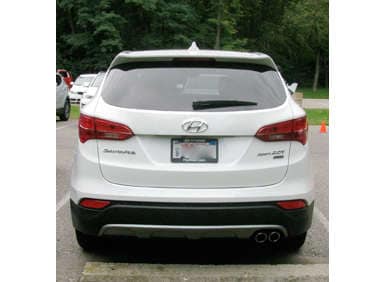Recent Articles
Popular Makes
Body Types
2013 Hyundai Santa Fe Sport: First Impressions
All-new Mid-size Crossover Aims High and Delivers
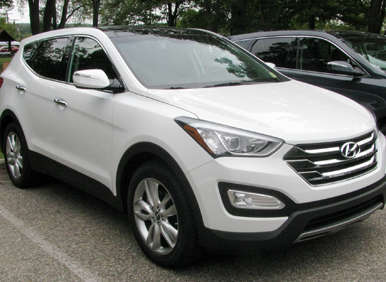
The short story here is a simple one: Hyundai’s relentless push up-market continues with the 2013 Hyundai Santa Fe Sport, which steps in as the replacement for the 2012 Santa Fe as the brand’s mid-size five-passenger crossover contender. (The “Santa Fe” moniker, without the “Sport,” will be used on a long-wheelbase, three-row version that is due to arrive in dealerships early next year.)
The Santa Fe Sport adds more than an athletic appellation to the old-school Santa Fe, though. It’s been comprehensively updated from stem to stern and now speaks a new dialect of Hyundai’s fluidic sculpture design language, while also introducing a more sophisticated, high-versatility cabin, with a surprisingly strong roster of premium amenities, all while offering two fairly athletic powertrains choices. Of course, all the upgrades do add more than $1,200 to the vehicle’s MSRP—as compared to the 2012 Santa Fe—although there’s plenty of value here even with a starting point of $24,450. Which I discovered during a recent press drive event sponsored by the ever-helpful folks at Hyundai, who also sprang for breakfast and lunch, too!
Check out some of the highlights …
2013 Hyundai Santa Fe Sport: A New Look
Yes, the 2013 Hyundai Santa Fe Sport introduces an evolution of the brand’s approach to style, now positioned as “fluidic precision,” and yes, the results are fairly impressive, but the biggest take-away from the press event was how different it actually looks from the bigger, long-wheelbase model. In addition to a flock of Santa Fe Sports, Hyundai also had a prototype of the latter vehicle on hand, and despite claims the two are identical from the B-pillar forward, the pair has notably different fog-light shapes, grilles, profiles, lower valances, daylight openings, and exhaust-outlet configurations.
There’s no need to belabor the point, but the differentiation should be a plus for customers who put an emphasis on distinctive style. And that’s something the Santa Fe Sport certainly offers, thanks to a blunter, three-bar grille that significantly reduces front overhang, a relatively high beltline enhanced by dramatically shaped rear-most side windows, a rugged-looking two-tone lower front fascia, and some nifty wheel choices. A particularly nice touch are the LED light pipes integrated into the vehicle’s side mirrors as turn indicators.
A much more sophisticated template was used for interior design as well, providing a more complex and dimensional environment that, in fact, may be too busy for some. But the materials and attention to detail are above average for the class in most places (marred primarily by some hard plastic around the glovebox and an awkward transition between the front doors and the dash).
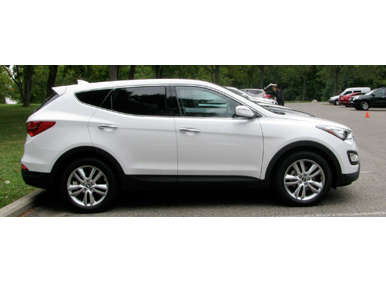
2013 Hyundai Santa Fe Sport: Cabin Pleasure
For all its style and sophistication, the 2013 Hyundai Santa Fe Sport doesn’t forget that, deep down, it’s supposed to be a family-friendly alternative to the likes of the Chevy Equinox, Ford Edge and Nissan Murano. Thus, the Hyundai has more cargo space than that trio regardless of whether their second rows are folded flat or in their upright positions, and without giving up more than a few cubic inches in terms of passenger volume. To quantify things here a bit, the Santa Fe Sport is 184.6 inches long, nestling between the compact Ford Escape (178.1 inches) and the also-mid-size Equinox (187.8 inches). Yet on the inside, the Hyundai's passenger volume of 108 cubic feet and 35.4 cubic feet of space in the rear cargo area compare to 99.7 and 31.4 in the longer Chevy.
The Santa Fe Sport’s rear seats also are quite functional, with a helpful 40/20/40 split and the ability to both recline and slide for added comfort. They also can be folded down using a quick-release feature in the rear cargo hold, while mounting the temporary spare tire outside and below that space allowed engineers to design in some useful underfloor storage.
Then, along with expected premium features like a heated steering wheel, heated front seats, navigation, rear-seat climate vents and a panoramic sunroof, the 2013 Hyundai Santa Fe Sport has a couple of surprises usually available only from lux makers. Among them: Heated rear seats, manual sunshades for second-row side windows, and an audiophile-style Infinity Logic 7 surround-sound system from the experts at Harman Audio. It delivers 550-watts of power, 12 speakers and sound performance that was specifically tuned for the Santa Fe Sport’s cabin.
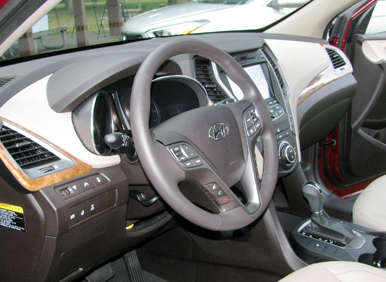
2013 Hyundai Santa Fe Sport: Powertrain Review
Two engines are available in the 2013 Hyundai Santa Fe Sport, both mated to the automaker’s six-speed automatic transmission. The starter unit produces a healthy 190 hp and 181 lb.-ft. of torque, with both marks coming in near the top of the segment, and returns an EPA line of 22 mpg city/33 mpg highway/26 mpg combined—that’s currently the highest highway mark of any automatically transmissioned crossover in the country. (The all-new 2013 Buick Encore will be capable of 25/33/28 when it arrives, but it’s more than 16 inches shorter than the Hyundai.)
But what really puts the “Sport” into the Santa Fe Sport is the available 2.0-liter turbo that makes 264 hp and 269 lb.-ft. of torque, and is ensconced in one of the lightest vehicles in its class. With a curb weight of 3,569 lbs., the sporty Santa Fe is 266 lbs. lighter than the outgoing version and more than 480 lbs. beneath the weight of the EcoBoosted Ford Edge. And it even scores slightly better EPA grades than the Ford, with ratings of 21 mpg city/31 mpg highway/25 mpg combined.
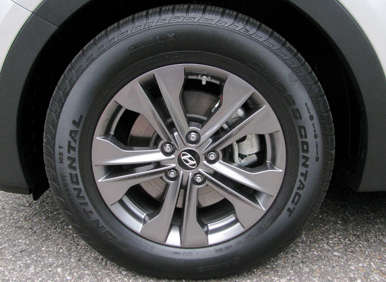
2013 Hyundai Santa Fe Sport: First Drive
Now we come to the good stuff: I was able to pilot the Hyundai Santa Fe Sport 2.0T, with and without all-wheel drive, in both city and highway conditions, and can report that—especially in that first configuration—the 2013 Hyundai Santa Fe Sport provides a nimble, engaging driving experience that is notably above average for the class. The turbocharged engine provides plenty of power and torque, even at the lower end of the rpm spectrum, and more importantly, it does so without straining. The powerplant sounded and felt confident when accelerating from a stop or out of a turn, while it also was surprisingly capable at highway speeds. I never pushed it beyond 85 mph on the expressway, but I clearly could have, and the ride at that velocity was so stable and serene I thought I was doing about 20 mph slower than I actually was. Wind noise, though, was a minor issue.
At the same time, I also managed about 25.7 mpg. True, some of that was accomplished when enabling the Santa Fe Sport’s standard Econ mode, but a lot of it also came under more aggressive driving scenarios.
Off the expressway, the 2013 Hyundai Santa Fe Sport handled the back roads of mid-Michigan with aplomb, thanks to its MacPherson front/multi-link rear suspension with standard stabilizer bars at both ends. With the caveat that I’m comparing the Hyundai to other mid-size-ish crossovers, it stayed well planted in the turns, with minimal body roll and responsive steering.
Comparatively speaking, the all-wheel-drive model—with a new Active Cornering Control feature—felt a bit bogged down; the FWD model is the driver's choice, even with that cornering tech providing assistance by adjusting torque and braking at the rear wheels for improved turning prowess.
My only real disappointment with the driving experience involved the vehicle’s brakes, which were noticeably too sensitive for my tastes.
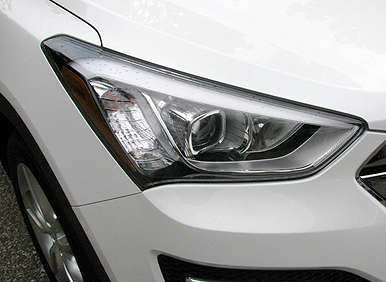
2013 Hyundai Santa Fe Sport: Counterpoint
Although I enjoyed my time in Hyundai’s new crossover, there are some nits to pick. For one, the automaker made much of its Driver Selectable Steering Mode system, a standard bit of technology that allows owners to choose between three differing levels of steering performance. However, it doesn’t really add much to the driving experience, since the “Comfort” mode was much too light, even for city driving, and the “Sport” mode swung the pendulum too far in the other direction.
Then, for all of its standard and available goodies, you won’t find safety features like blind-spot alert, lane-departure warning or front-collision alert on the list. Now, not all of the Santa Fe Sport’s rivals offer these kinds of benefits, but the Edge and Equinox do, and their omission from the Hyundai does stand out when you remember it’s an all-new vehicle.
My last complaint is one of those things that, frankly, drives me a little crazy about automakers. Remember that underfloor storage I praised above? It includes a handy storage tray for managing cargo, but said tray is made out of Styrofoam. Hyundai made sure it was black, which I suppose was an attempt to give it an upscale look, but one touch and you know what it is. Worse, it doesn’t exactly help Hyundai’s green cred; but I guess if it’s good enough for the Lexus CT hybrid—which it was the last time I drove that car—it should fit right in with the 2013 Hyundai Santa Fe Sport.
Photos courtesy of Charles Krome. Test vehicle courtesy of Hyundai.
